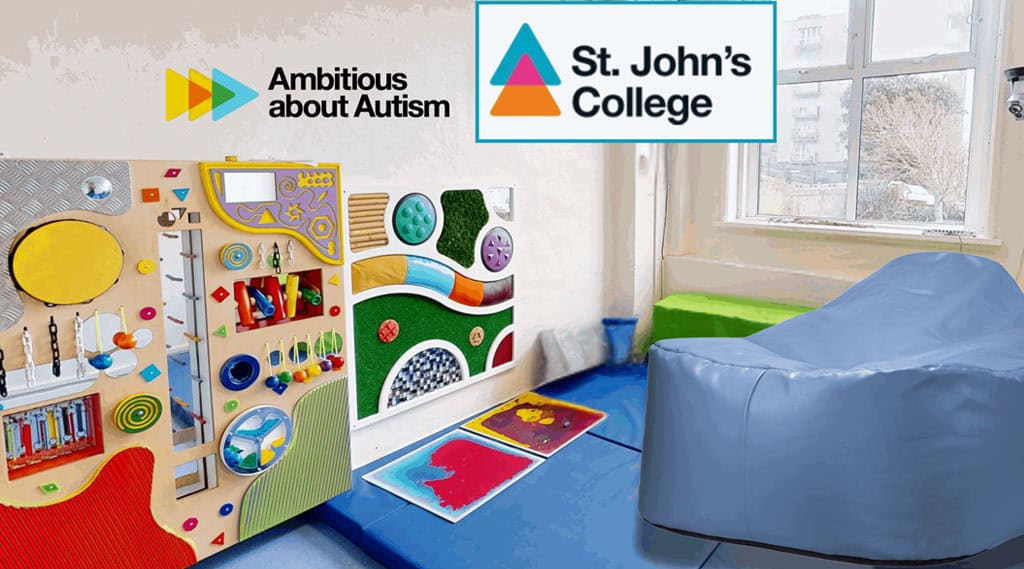St JohnsCollege
Implementing Safety Pods at St. John’s College
Client: St John’s College
Product: Safety Pods

St. John’s College, a specialist educational institution, provides support for young people with complex needs, including emotional and behavioural challenges. A key focus of the school’s approach is to create a safe and nurturing environment that encourages autonomy and emotional regulation, while also maintaining the safety and dignity of both students and staff. In response to the need for more effective and compassionate crisis intervention techniques, the school invested in the addition of Safety Pods.
The decision to invest in Safety Pods stemmed from a desire to find more effective and humane ways to support young people during emotional crises. Staff members at St. John’s felt that traditional crisis intervention methods, such as physical restraint, often led to the loss of dignity for the student and could have long-term negative effects on the student’s mental and emotional wellbeing.
The Safety Pods provided an alternative that allowed students to regulate themselves in a safe, contained space. The design of the pods supports young people in a non-restrictive manner, giving them the opportunity to de-escalate without the need for physical intervention. This approach helps to preserve the relationship between students and staff, reduces the risk of trauma, and promotes the development of self-regulation skills.
Importantly, the Safety Pods are also equipped with techniques that allow for the safe, dignified management of situations where a restrictive intervention may still be necessary, ensuring that the student’s safety and wellbeing are always prioritized.
One of the most significant examples of how the Safety Pods have positively impacted a student’s behaviour comes from a young man at the school who frequently exhibited physical aggression when faced with challenging demands. Prior to the introduction of the Safety Pod, this student exhibited warning signs of emotional dysregulation but refused to engage in calming strategies or environmental adjustments such as reducing sensory stimuli or giving space. When his behaviour escalated, he would often physically lash out, attempting to punch and kick staff members. Due to his hypermobility, size, and strength, staff found it difficult to safely restrain him. In these situations, the only option was often to employ a supine hold, which posed significant risks to both the student and staff.
After witnessing the effectiveness of the Safety Pod at a Maybo conference, the team decided to purchase a pod specifically for this student. Prior to the acquisition, restrictive interventions were used 3-4 times a week to manage the student’s behaviour. However, after introducing the Safety Pod and using the wrap-reverse disengage technique as a proactive measure, the student was able to self-regulate more effectively.
Over a period of two months, the frequency of restrictive interventions drastically decreased, and the student rarely required physical intervention. The key change was the student’s increasing ability to recognise the safety pod as a space to self-regulate. He began to choose to go to the Pod when he felt dysregulated, allowing him to calm down without the need for physical restraint. Gradually, he began to engage more in classroom activities and build stronger relationships with both peers and staff. As a result, his overall quality of life and emotional wellbeing improved, marking a significant positive shift in both his behaviour and his academic engagement.
From a staff perspective, the introduction of the Safety Pods has been transformative. The availability of the Pod provided a more proactive approach to managing emotional dysregulation, giving staff greater confidence in their ability to manage crisis situations without immediately resorting to restrictive interventions. This shift has not only enhanced the staff’s sense of safety and competence but has also resulted in a reduction in the use of physical intervention techniques.
Moreover, the use of the Safety Pod has improved relationships between staff and students. The ability to manage emotional crises in a less invasive, more dignified manner has fostered trust and respect, which has directly impacted students’ self-esteem and confidence. As a result, students are more engaged in classroom activities, more likely to interact positively with their peers, and better equipped to regulate their own emotions.
The introduction of the Safety Pods has contributed to a broader cultural shift within the setting. By offering an alternative to physical restraint, the college has moved away from a reactive, crisis-driven model of behaviour management towards one that focuses on prevention, autonomy, and emotional support. The Safety Pods have helped staff view crisis situations not as opportunities for control, but as moments for teaching self-regulation and emotional resilience.
The decision to incorporate Safety Pods into the school’s crisis management toolkit has had a profoundly positive impact on both students and staff at St. John’s College. By providing a safe, dignified space for emotional regulation, the Safety Pods have reduced the need for physical intervention, improved student behaviour, and fostered stronger, more positive relationships between staff and students. The ability to support young people in crisis without resorting to restrictive measures has not only improved the overall safety and wellbeing of students but also contributed to a more compassionate, effective approach to supporting their emotional and behavioural development.
Key Outcomes
- Reduced frequency of restrictive interventions (from 3-4 times per week to rarely required)
- Increased self-regulation and autonomy among students
- Increased self-regulation and autonomy among students
- Enhanced staff confidence in managing crises and employing proactive strategies
- Shift towards a more positive, preventative approach to crisis management across the school
The success of the Safety Pods at St. John’s highlights the value of investing in tools that prioritize dignity, safety, and emotional wellbeing, ultimately benefiting both students and staff.

